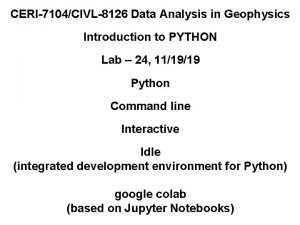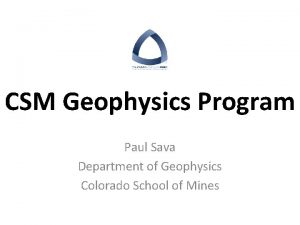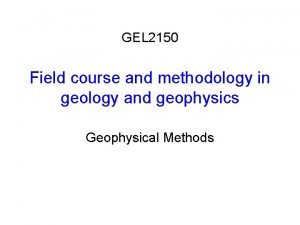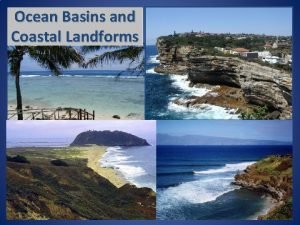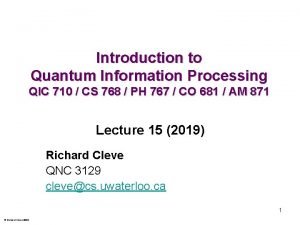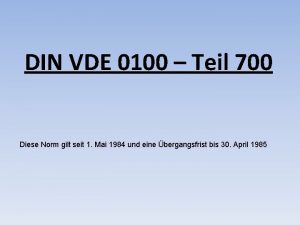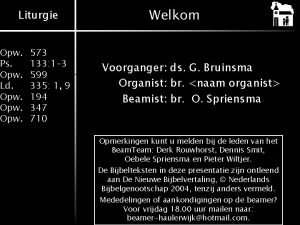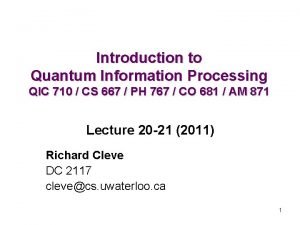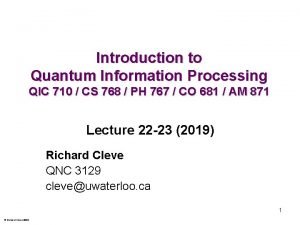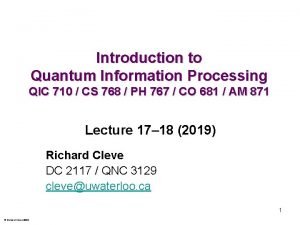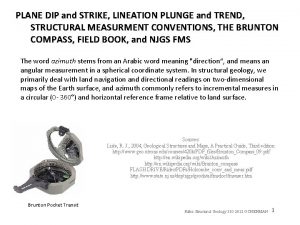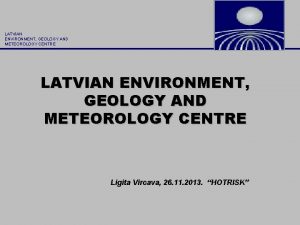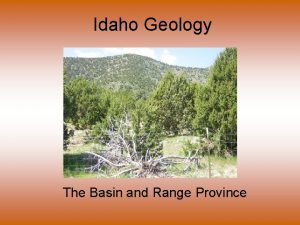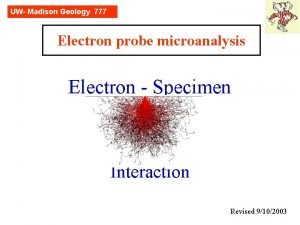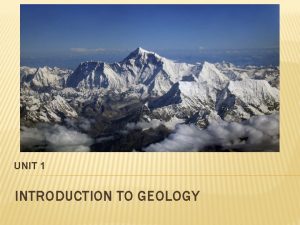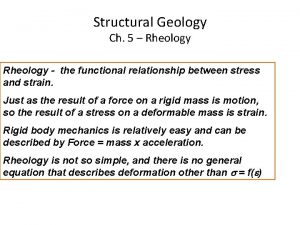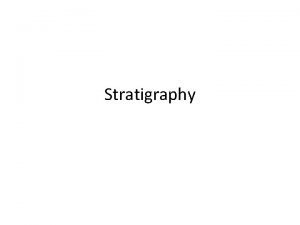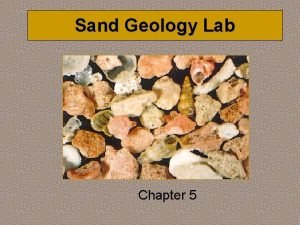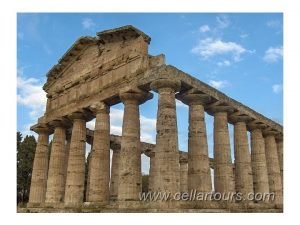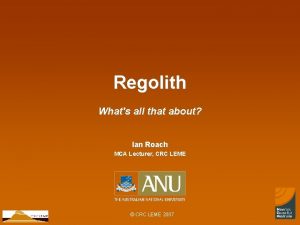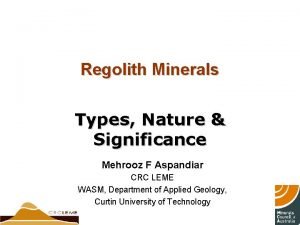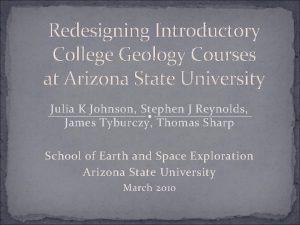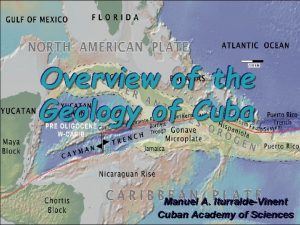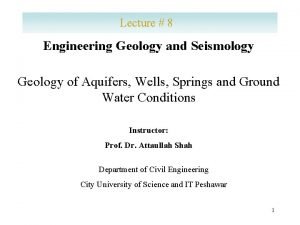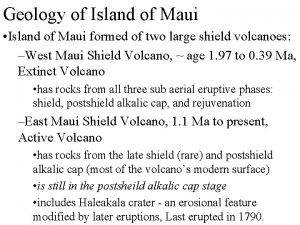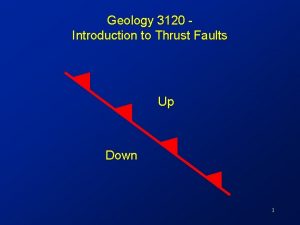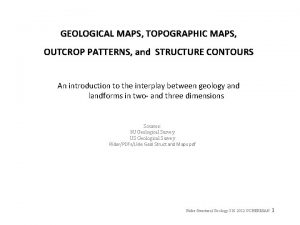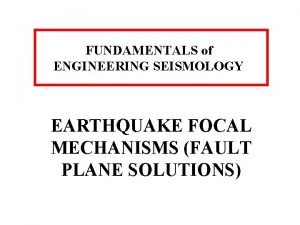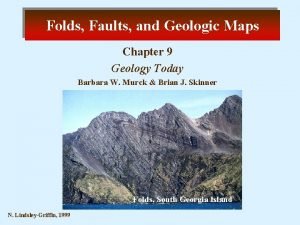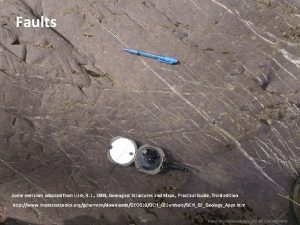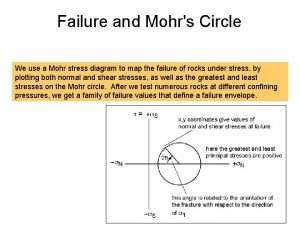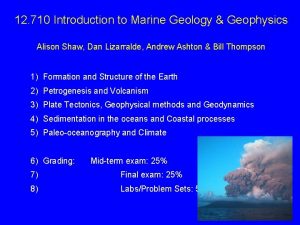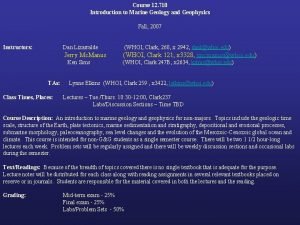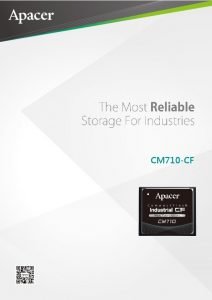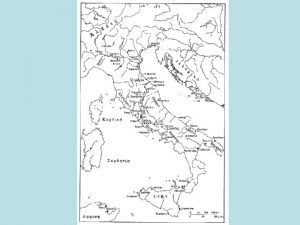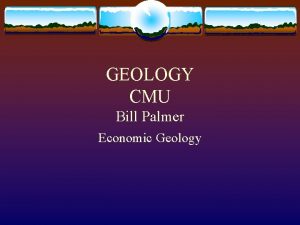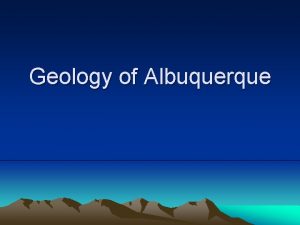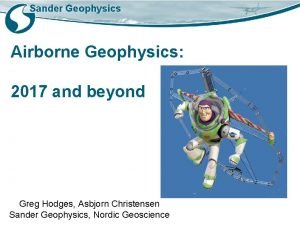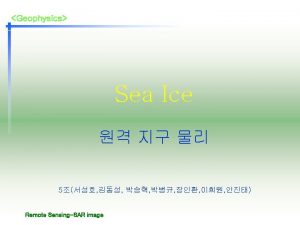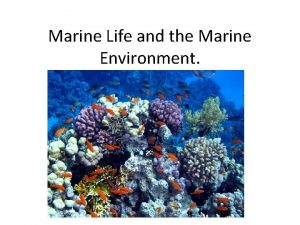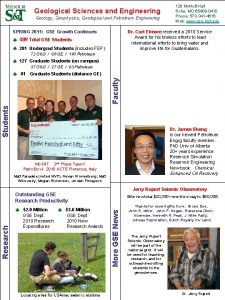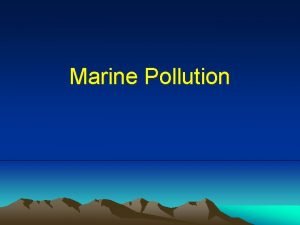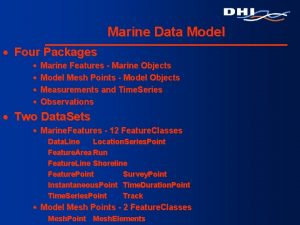12 710 Intoduction to Marine Geology and Geophysics










































- Slides: 42


12. 710 Intoduction to Marine Geology and Geophysics 11/1 Mid Term Sediments, Processes, and the Sedimentary Record 11/6 11/8 (Mc. Manus) Deep-sea sediments: composition, distribution Biological, chemical, and physical abyssal processes 11/13 11/15 (Mc. Manus) Dating methods and the sedimentary record Paleo-environmental proxies 11/20 (Mc. Manus) Deep water chemistry and atmospheric p(CO 2) 11/22 Thanksgiving 11/27 11/29 (Hoffmann) (Thompson) Paleothermometry Pleistocene ice-age cycles 12/4 (Mc. Manus) Sedimentary records of abrupt climate change 12/6 Final Exam

j��� ökulhlaups Catastrophic flooding associated with sub-glacial volcanic eruptions

Past climate changes I II Milankovitch and the “Astronomical” or “Orbital” theory of the ice ages. Successes and potential failures of Milankovitch. III IV V Abrupt climate change. External mechanisms of rapid climate change: Non-linear orbital forcing. Variable solar luminosity. Aliased seasonal cycle. Internal mechanisms of rapid climate change: Binge-purge ice sheet instability. Salt oscillator ocean circulation. Tropical ocean-atmospheric dynamics.

Long-term decline into glaciation Oxygen isotopes in benthic foraminifera from deep-sea sediments reveal a cooling trend on Earth over tens of millions of years.

Cold (even) 18 Oforams Warm (odd) MARINE ISOTOPE STAGES (MIS)

Milutin Milankovitch Serbian mathematician who painstakingly calculated the insolation effects of changes in the Earth’s orbital parameters.

Eccentricity Variations in the shape of the Earth’s orbit around the sun, from circular to more elliptical, occur over ~100, 000 years.

Obliquity Variations in the tilt of the Earth’s axis of rotation, driving contrasts in seasonality, occur over ~40, 000 years.

Precession Variations in the orientation of the Earth’s tilted axis of rotation, moving seasons along the eccentric orbit, occur over ~20, 000 years.

Orbital variations in received insolation Each orbital influence has its own distinctive pattern of influence through time. They combine to vary sunlight on Earth.

Specmap Study of isotope and other paleo-climate records from deepsea sediments around the world reveals Milankovitch signal. Period (1/frequency) in thousands of years.

Devil’s Hole Well dated speleothem record not consistent with Milankovitch? Should it? Remains an unsolved puzzle.

Abrupt climate change Evidence from ice cores and deep-sea sediments reveals climate changes that seem too abrupt to be explained orbitally.


Dansgaard-Oeschger Cycles discovered in Greenland ice cold 18 Oice warm

cooler warmer N. Atlantic SSTs track Greenland Air Temperatures H-events occurred during extreme cold phases of D-O cycles in Greenland ice

THE YOUNGER DRYAS IN THE SANTA BARBARA BASIN • Increased bioturbation suggesting higher O 2 levels (D-O interstadials show the opposite with reduced bioturbation) • Increased 18 Obenthic • Increased Pacific ventilation?

GLOBAL SIGNATURE OF D/O EVENTS: CARIACO BASIN

ANTI-PHASING BETWEEN HEMISPHERES Antarctica warms during the Younger Dryas

THE DISCOVERY OF HEINRICH EVENTS….

…. IN MARINE SEDIMENT ARCHIVES

Transport of ice-rafted debris (IRD)

Site with ice-rafted debris Site without ice-rafted debris “IRD Belt” - based on network of N. Atlantic marine sediment records

MECHANISMS BEHIND MILLENNIAL VARIABILITY EXTERNAL FORCING • Suborbital (Combination tones) • Solar Variability INTERNAL FORCING • Ice sheets (e. g. , “Binge-Purge” theory) • Thermohaline circulation (e. g. , Broecker’s “Salt Oscillator”) • Tropical Dynamics (e. g. , Eastern tropical Pacific - ENSO dynamics) ALTERNATIVE • Aliasing

SUBORBITAL FORCING: MILANKOVITCH COMBINATION TONES Tropical Atlantic coccolith abundance records: Variations in tropical winds/upwelling cause ice rafting events? F. profunda (upwelling indicator) maxima coeval with Heinrich events Spectral Analysis: -spectral power at 8. 4 ky (7. 6 ky 14 C), a combination tone of precession and eccentricity The mechanism: Easterly winds diminish, warm water propagates northward via the Gulf Stream, delivery of heat causes ice sheet melting and subsequent iceberg discharge Mc. Intyre and Molfino (1996)

SOLAR VARIABILITY: IRD and Cosmogenic Nuclides in the Holocene 10 Be 14 C Similar pacing of ice rafting events during last interglacial (MIS-5) Bond et al. (2001)

ICE SHEET STABILITY: THE BINGE-PURGE THEORY Mac. Ayeal’s explanation for Heinrich Events B PURGE GE N I ~7 ky pacing Laurentide Ice Sheet (LIS) Model: Purge phase - geothermal flux gradually increases basal temperature, thawing basal sediments; rapid discharge of icebergs; (meltwater input reduces THC, cool North Atlantic, allowing ice growth again) E G N BI ~7 ky pacing PURGE Binge (Growth) phase - basal sediment frozen, ice sheet immobile; slow growth of LIS

THERMOHALINE CIRCULATION: THE SALT OSCILLATOR Conveyor On: Northward heat transport initiates ice melting, which reduces density of upper ocean, reducing deep water formation Conveyor Off: Cooling of North Atlantic (less melt water input) and reduced salt export gradually increase density (and thus deep water formation); return to Conveyor On mode

Three Modes of North Atlantic Deep Ocean Circulation Oc/Atm

TROPICAL DYNAMICS: EASTERN TROPICAL PACIFIC The Idea: El Niño/Southern Oscillation (ENSO) system in the eastern tropical Pacific affects tropical SST distribution, which controls convection/atmospheric circulation patterns - very strong teleconnections, which could explain near-global synchroneity of millennial events EVENT FREQUENCY EVENT AMPLITUDE Experiment: Coupled oceanatmosphere model of the tropical Pacific is run for 150, 000 years, both with and without orbital (precession) forcing Result: Millennial increases or decreases in the frequency of ENSO warm or cold events and changes in their amplitudes Clement et al. (1999)

THE PROBLEM OF ALIASING


D-O events show up in major ion chemistry of Greenland ice Polar Circulation Index (PCI) • Record developed from the analysis of GISP 2 major ion chemistry • Proxy for relative measure of the average size and intensity of polar atmospheric circulation • Generally increase (e. g. , more continental dusts and marine contributions) during stadials and decrease during interstadials

SPECTRAL ANALYSIS OF THE PCI Dominant periodicity in millennial band is 1450 years

GLOBAL SIGNATURE OF D/O EVENTS: ARABIAN SEA Greenland 18 Oice Increased prod. , lower O 2 bioturbated laminated Total organic carbon (TOC) records from two marine sediment cores off Pakistan showing millennialscale variability of monsoonal surface water productivity and bottom-water oxygen

D/O temperature oscillations also occur in Antarctica (Vostok), but with generally smaller amplitudes

HEINRICH EVENTS • Helmut Heinrich discovered a cyclic pattern of ice-rafted debris over the last 130 ky in a series of sediment records from the North Atlantic • Broecker and Bond later identified six of these events between 70 and 14 ky B. P. , and named them Heinrich events (H 1 -H 6) • Heinrich events occur every ~7 -10 ky, and are associated with pronounced cooling in the Greenland ice core records and North Atlantic region • Bond et al. (1993) noted that Heinrich events appear to occur towards the end of increasingly colder D-O cycles

SEDIMENTARY CHARACTERISTICS OF A HEINRICH LAYER

OTHER TYPES OF IRD FOUND IN THE NORTH ATLANTIC Hematite-stained grains Basaltic glass, Iceland

HEINRICH EVENT CHRONOLOGY IRD peaks Bond et al. (1992)

BOND IDENTIFIES MORE IRD PEAKS IN N. ATLANTIC SEDIMENTS In addition to Heinrich events (Huge IRD peaks, cold Greenland air temp. and cold N. Atl. SST)… Cold phases of D -O cycles smaller amplitude IRD peaks; smaller SST signal COLDER Bond and Lotti (1995) COLDER
 Python for geophysics
Python for geophysics Paul sava
Paul sava Seismology
Seismology Wireline geophysics
Wireline geophysics Cliff terrace caves stacks
Cliff terrace caves stacks 710-2-1
710-2-1 Qic 710
Qic 710 Vde 0100-700
Vde 0100-700 650 en yakın onluğa yuvarlama
650 en yakın onluğa yuvarlama Ortec 710
Ortec 710 A gas has a pressure of 710 kpa at 227
A gas has a pressure of 710 kpa at 227 Variables on both sides word problems worksheet
Variables on both sides word problems worksheet Opw 710
Opw 710 Qic 710
Qic 710 Qic710
Qic710 Qic 710
Qic 710 Division 2 quartermaster location
Division 2 quartermaster location Euperlan pco basf
Euperlan pco basf Strike and dip vs. trend and plunge
Strike and dip vs. trend and plunge Latvian environment, geology and meteorology centre
Latvian environment, geology and meteorology centre Basin and range geology
Basin and range geology Xvfk
Xvfk Geology
Geology What is geology?
What is geology? Structural geology
Structural geology What is stratigraphy
What is stratigraphy Geology lecture series
Geology lecture series Grain size card
Grain size card Types of differential stress
Types of differential stress Define regolith
Define regolith Mineral council australia
Mineral council australia Arizona state university geology
Arizona state university geology Geology of cuba
Geology of cuba Confined and unconfined aquifer
Confined and unconfined aquifer Geology of maui
Geology of maui Thrust geology
Thrust geology Steeply dipping beds
Steeply dipping beds Mica hardness
Mica hardness Gcse geology
Gcse geology Seismic beach balls
Seismic beach balls Osn
Osn Cassie de lisla
Cassie de lisla Mohrs law
Mohrs law
